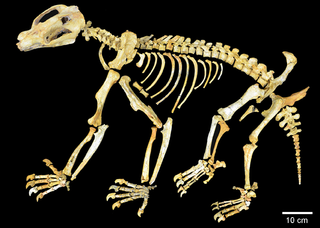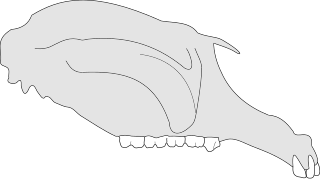
Diprotodon is an extinct genus of marsupial from the Pleistocene of Australia containing one species, D. optatum. The earliest finds date to 1.77 million to 780,000 years ago but most specimens are dated to after 110,000 years ago. Its remains were first unearthed in 1830 in Wellington Caves, New South Wales, and contemporaneous paleontologists guessed they belonged to rhinos, elephants, hippos or dugongs. Diprotodon was formally described by English naturalist Richard Owen in 1838, and was the first named Australian fossil mammal, and led Owen to become the foremost authority of his time on other marsupials and Australian megafauna, which were enigmatic to European science.

Marsupials are any members of the mammalian infraclass Marsupialia. All extant marsupials are endemic to Australasia, Wallacea and the Americas. A distinctive characteristic common to most of these species is that the young are carried in a pouch. Living marsupials include opossums, Tasmanian devils, kangaroos, koalas, wombats, wallabies, and bandicoots among others, while many extinct species, such as the thylacine, are also known.

Ungulates are members of the diverse clade Euungulata which primarily consists of large mammals with hooves. Once part of the clade "Ungulata" along with the clade Paenungulata, "Ungulata" has since been determined to be a polyphyletic and thereby invalid clade based on molecular data. As a result, true ungulates had since been reclassified to the newer clade Euungulata in 2001 within the clade Laurasiatheria while Paenungulata has been reclassified to a distant clade Afrotheria. Living ungulates are divided into two orders: Perissodactyla including equines, rhinoceroses, and tapirs; and Artiodactyla including cattle, antelope, pigs, giraffes, camels, sheep, deer, and hippopotamuses, among others. Cetaceans such as whales, dolphins, and porpoises are also classified as artiodactyls, although they do not have hooves. Most terrestrial ungulates use the hoofed tips of their toes to support their body weight while standing or moving. Two other orders of ungulates, Notoungulata and Litopterna, both native to South America, became extinct at the end of the Pleistocene, around 12,000 years ago.

Diprotodontia is the largest extant order of marsupials, with about 155 species, including the kangaroos, wallabies, possums, koala, wombats, and many others. Extinct diprotodonts include the hippopotamus-sized Diprotodon, and Thylacoleo, the so-called "marsupial lion".

The Vombatiformes are one of the three suborders of the large marsupial order Diprotodontia. Seven of the nine known families within this suborder are extinct; only the families Phascolarctidae, with the koala, and Vombatidae, with three extant species of wombat, survive.

Australidelphia is the superorder that contains roughly three-quarters of all marsupials, including all those native to Australasia and a single species — the monito del monte — from South America. All other American marsupials are members of the Ameridelphia. Analysis of retrotransposon insertion sites in the nuclear DNA of a variety of marsupials has shown that the South American monito del monte's lineage is the most basal of the superorder.

Thylacoleo is an extinct genus of carnivorous marsupials that lived in Australia from the late Pliocene to the late Pleistocene. Some of these marsupial lions were the largest mammalian predators in Australia of their time, with Thylacoleo carnifex approaching the weight of a lioness. The estimated average weight for the species ranges from 101 to 130 kg.

The term Australian megafauna refers to the megafauna in Australia during the Pleistocene Epoch. Most of these species became extinct during the latter half of the Pleistocene, and the roles of human and climatic factors in their extinction are contested.

Macropus is a marsupial genus in the family Macropodidae. It has two extant species of large terrestrial kangaroos. The term is derived from the Ancient Greek μάκρος, makros "long" and πους, pous "foot". Thirteen known extinct species are recognised. The type species is the eastern grey kangaroo.

Thylacoleonidae is a family of extinct carnivorous diprotodontian marsupials from Australia, referred to as marsupial lions. The best known is Thylacoleo carnifex, also called the marsupial lion. The clade ranged from the Late Oligocene to the Late Pleistocene, with some species the size of a possum and others as large as that of a leopard. As a whole, they were largely arboreal, in contrast to the mostly terrestrial dasyuromorphs, monitor lizards and mekosuchines, though members of Thylacoleo were likely primarily terrestrial with some climbing capabilities.

Palorchestes is an extinct genus of large terrestrial, herbivorous Australian marsupial of the family Palorchestidae, living from the Miocene through to the Late Pleistocene. Like other palorchestids, it had highly retracted nasal region suggesting that it had a prehensile lip, as well as highly unusual clawed forelimbs that were used to grasp vegetation.

Nimbadon is an extinct genus of marsupial, that lived from the Late Oligocene to the Miocene epoches. Many fossils have been found in the Riversleigh World Heritage property in north-western Queensland. It is thought to have an arboreal lifestyle.

Phascolonus is an extinct genus of giant wombat known from the Pliocene and Pleistocene of Australia. There is only a single species, Phascolonus gigas, the largest wombat ever known to have existed, estimated to weigh as much as 200 kg or 360 kg (790 lb). It was described by Richard Owen in 1859. Phascolomys magnus is a probable junior synonym. P. gigas is distinguished from other wombats by its strap-shaped upper incisors. The cranial roof is noticeably inwardly depressed. The species was abundant across Australia, with remains having been found in all states except Western Australia. It is suggested to have had a preference for arid and semi-arid inland habitats, with a diet consisting of a high amount of low quality vegetation. Though it likely had wide home-ranges, it probably did not stray far from fresh water sources. Abundant remains have been found in Pleistocene aged deposits from Lake Callabonna in South Australia. Unlike its living relatives, it is unlikely that Phascolonus engaged in burrowing. Phascolonus disappeared during the Late Pleistocene Quaternary extinction event around 50-40,000 years ago, together with many other large Australian animals, following the arrival of humans to the Australian continent. Phylogenetic analysis suggests that is closely related to the other giant wombat genera Ramsayia and Sedophascolomys.

Diprotodontidae is an extinct family of large herbivorous marsupials, endemic to Australia and New Guinea during the Oligocene through Pleistocene periods from 28.4 million to 40,000 years ago.

Litokoala is an extinct genus of marsupials, and along with Nimiokoala, is closely related to the modern koala. The three genera may have diverged at an earlier date, although the drying of the continent and the expansion of Eucalyptus forests towards the late Miocene may have delayed the evolution of cranial features unique to the modern genera. This indicates that either fossil genus could be an ancestor of the modern genus, or the modern genus has a common ancestor to both. More material needs collection to improve their taxonomical relationships.
Ngapakaldia is an extinct genus of diprotodontid marsupials, related to the modern koala and wombat. Around the size of a sheep, it was a ground-dwelling herbivore that lived around the vegetated shores of lakes in Central Australia during the Late Oligocene.
Riversleigh fauna is the collective term for any species of animal identified in fossil sites located in the Riversleigh World Heritage Area.

Propalorchestes is a fossil genus of palorchestid marsupial that existed in Australia during the Miocene epoch.
Karen H. Black, born about 1970, is a palaeontologist at the University of New South Wales. Black is the leading author on research describing new families, genera and species of fossil mammals. She is interested in understanding faunal change and community structure in order to gain new understandings of past, current and future changes in biodiversity which are driven by climate.
Sedophascolomys is an extinct genus of wombat known from the Pliocene and Pleistocene of Australia. There is a single recognised species, S. medius, which was formerly placed in the invalid genus Phascolomys. It was found in the northeastern and eastern regions of the continent. It is estimated to be somewhat larger than extant wombats, with a body mass of 70-75 kilograms. The youngest remains of the genus date to the Late Pleistocene, around 50-40,000 years ago. It is thought to be closely related to the giant wombat genera Phascolonus and Ramsayia.


















